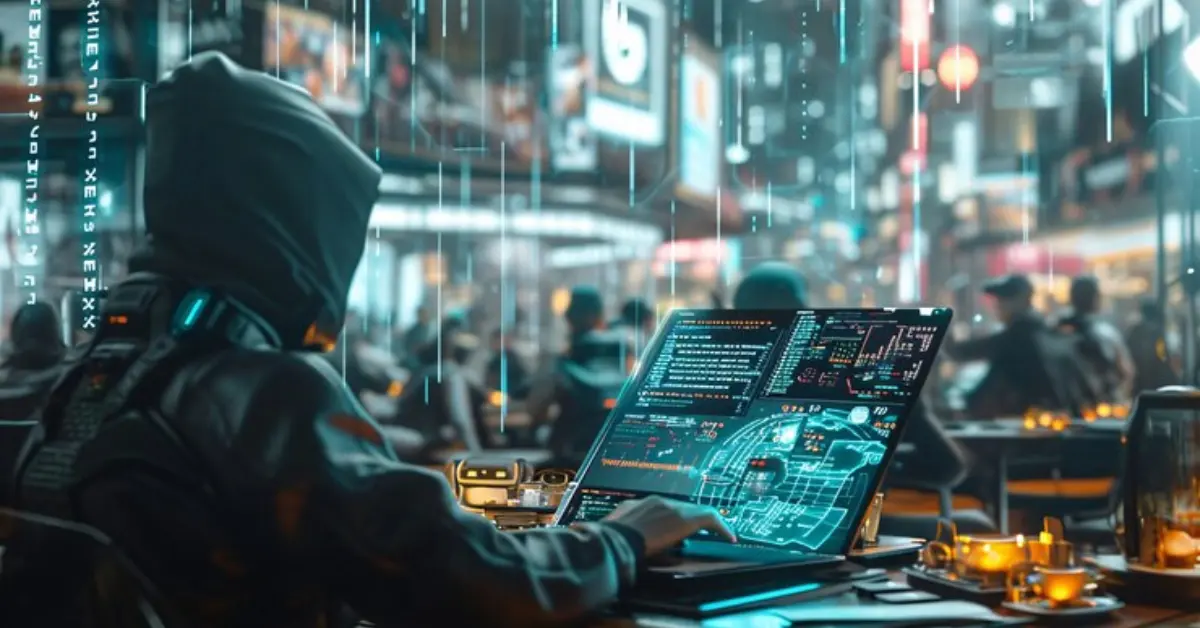Introduction
In the ever-evolving landscape of cybersecurity, the integration of Artificial Intelligence (AI) has emerged as a pivotal force. As organizations grapple with the escalating sophistication of cyber threats, the question arises: is AI a friend or foe in the realm of cybersecurity? This article delves into the transformative role of AI in bolstering digital defenses while exploring potential challenges and ethical considerations.
The Symbiosis of AI and Cybersecurity
The symbiotic relationship between Artificial Intelligence (AI) and cybersecurity is reshaping the digital landscape, ushering in a new era of defense against ever-evolving cyber threats. This dynamic partnership represents a harmonious blend of advanced technology and human expertise, creating a formidable alliance to safeguard sensitive information and critical systems.
AI’s Analytical Prowess:
At the heart of this symbiosis lies AI’s unparalleled analytical prowess. Through machine learning algorithms, AI can process vast amounts of data at incredible speeds, identifying patterns and anomalies that might escape the human eye. This capability is a game-changer in the realm of cybersecurity, where early detection of potential threats can mean the difference between a secure system and a compromised one.
By analyzing historical data and learning from past incidents, AI systems can predict and proactively mitigate emerging risks. This proactive approach enhances the overall security posture, allowing organizations to stay ahead of cyber adversaries who are constantly devising new tactics.
Automation Unleashed:
The marriage of AI and cybersecurity brings forth the power of automation. Mundane and repetitive tasks that once consumed significant human resources can now be streamlined and expedited through AI-driven automation. Routine security checks, system updates, and patch management are seamlessly handled, freeing up cybersecurity professionals to focus on more strategic and complex aspects of defense.
Automation not only enhances efficiency but also reduces response times. AI-driven systems can rapidly identify and contain threats, preventing potential damage before it escalates. This speed of response is crucial in the fast-paced and ever-changing landscape of cyber threats.
Ethical Considerations:
However, the partnership between AI and cybersecurity is not without its ethical considerations. As AI systems delve into vast amounts of data, privacy concerns arise. Striking a balance between harnessing the full potential of AI and respecting user privacy is a delicate task. Organizations must implement robust ethical frameworks and practices to ensure responsible and transparent use of AI in cybersecurity.
Moreover, the ethical dimension extends to the development and deployment of AI technologies. Ensuring that AI algorithms are unbiased, accountable, and adhere to ethical standards is paramount. Human oversight remains crucial to prevent unintended consequences and to address the moral implications of AI-driven decisions.
The Human Touch:
While AI contributes significantly to cybersecurity, the human touch remains irreplaceable. Cybersecurity professionals bring a nuanced understanding of context, ethical judgment, and creativity to the table – qualities that AI lacks. The symbiotic relationship between AI and human expertise is not about replacing one with the other but about leveraging the strengths of both.
Human intuition and adaptability are critical in dealing with novel and sophisticated threats that may not fit predefined patterns. The collaboration between AI and human professionals creates a synergy that amplifies the effectiveness of cybersecurity defenses.
A Resilient Future:
As the symbiosis between AI and cybersecurity deepens, the future promises a more resilient and adaptive defense against cyber threats. Ongoing advancements in AI technologies will continue to refine and augment cybersecurity capabilities. Organizations that embrace this symbiotic relationship, fostering collaboration between AI and human professionals, will be better equipped to navigate the complexities of the digital landscape and secure their digital assets against emerging threats. The evolving partnership between AI and cybersecurity is not just a technological evolution; it’s a strategic imperative in the ongoing battle for digital security.
Friendship in Automation
Friendship in automation heralds a transformative era in the realm of cybersecurity, where the integration of Artificial Intelligence (AI) brings forth unparalleled efficiency and effectiveness. As organizations grapple with the escalating complexity of cyber threats, the camaraderie between AI and automation emerges as a steadfast ally, alleviating the burden on cybersecurity professionals and fortifying digital defenses.
Swift Responses to Threats:
One of the most significant contributions of friendship in automation is the ability to respond swiftly to cyber threats. Mundane and time-consuming tasks that once required human intervention, such as routine security checks, system updates, and patch management, are now seamlessly handled by automated AI systems. This not only accelerates the pace of cybersecurity operations but also ensures that critical vulnerabilities are addressed in real-time, reducing the window of opportunity for cyber adversaries.
Automation enables continuous monitoring of network activities, swiftly detecting and neutralizing threats as they emerge. The instantaneous response capabilities of AI-driven automation provide a crucial advantage in the race against cyber attackers, enhancing the overall resilience of digital infrastructures.
Efficiency through Streamlined Processes:
Friendship in automation streamlines cybersecurity processes, optimizing resource utilization and allowing human professionals to focus on more strategic and complex aspects of defense. AI-driven automation excels in repetitive and rule-based tasks, ensuring accuracy and consistency in routine operations. This efficiency not only enhances the overall effectiveness of cybersecurity measures but also allows human experts to dedicate their expertise to tasks that require nuanced decision-making and creative problem-solving.
24/7 Vigilance:
The friendship between AI and automation extends beyond the limitations of human capabilities, providing 24/7 vigilance against cyber threats. Automated systems can tirelessly monitor network activities, identify anomalies, and respond to incidents around the clock. This continuous surveillance is crucial in an era where cyber threats can materialize at any moment, ensuring a proactive defense posture and minimizing the impact of potential breaches.
Challenges and Considerations:
While the friendship in automation offers numerous advantages, it is not without challenges. Organizations must navigate ethical considerations surrounding the responsible use of AI in automation. Striking a balance between leveraging the efficiency of automation and maintaining transparency, accountability, and privacy is paramount. Human oversight remains essential to ensure that automated systems align with ethical standards and do not inadvertently compromise privacy or perpetuate biases.
The Future Landscape:
As friendship in automation evolves, the future landscape of cybersecurity holds immense promise. The integration of AI-driven automation will likely become increasingly sophisticated, enabling organizations to stay ahead of the ever-evolving tactics employed by cyber adversaries. Embracing this friendship ensures that cybersecurity becomes a proactive and adaptive force, capable of safeguarding digital assets in the face of emerging threats.
Foe or Facilitator: Ethical Considerations
The integration of Artificial Intelligence (AI) in cybersecurity presents a paradigm where its role oscillates between being a formidable ally and a potential adversary. This dual nature raises critical ethical considerations that organizations must navigate to harness AI’s capabilities responsibly.
Privacy Concerns:
One of the foremost ethical considerations is the impact of AI on privacy. AI systems, particularly those leveraging machine learning for anomaly detection, require access to vast amounts of data to effectively identify and mitigate threats. This extensive data processing raises significant privacy concerns, especially regarding the collection, storage, and use of personally identifiable information (PII). Ensuring that AI systems adhere to strict privacy regulations and ethical standards without compromising their effectiveness is a delicate balance that organizations must maintain.
Bias and Fairness:
The potential for bias in AI algorithms represents another critical ethical consideration. AI systems are only as unbiased as the data they are trained on. If the training data contains inherent biases, the AI system may perpetuate or even amplify these biases in its operations. In the context of cybersecurity, biased AI could lead to disproportionate scrutiny of certain groups or overlook threats emanating from unexpected sources. Ensuring fairness and neutrality in AI-driven cybersecurity measures is imperative to maintain trust and effectiveness.
Accountability and Transparency:
The opaque nature of some AI algorithms, particularly those involving deep learning, poses challenges to accountability and transparency. When AI-driven systems make decisions, especially those affecting cybersecurity posture or incident response, the rationale behind these decisions must be understandable and transparent. Organizations must ensure that there is a clear framework for accountability, where decisions made by AI systems can be audited, reviewed, and, if necessary, reversed by human oversight.
Impact on the Cybersecurity Workforce:
The rapid integration of AI in cybersecurity also raises questions about the impact on the cybersecurity workforce. While AI can enhance efficiency and effectiveness, there is a concern that automation may displace human jobs. However, rather than viewing AI as a foe to cybersecurity employment, it should be seen as a facilitator that can augment human capabilities. Organizations should focus on reskilling and upskilling their cybersecurity workforce to work alongside AI, leveraging the unique strengths of both human and artificial intelligence.
The Future Landscape
The future landscape of cybersecurity is undergoing a profound transformation, shaped by the relentless evolution of technology and the dynamic interplay between cyber threats and defensive innovations. As we peer into the horizon, several key trends and developments emerge, outlining the contours of the cybersecurity landscape in the years to come.
1. AI Evolution:
Artificial Intelligence (AI) will continue to be a driving force in cybersecurity. The evolution of AI algorithms will lead to more sophisticated threat detection and response mechanisms. Machine learning models will become more adept at recognizing subtle patterns and anomalies, empowering cybersecurity systems to stay ahead of increasingly complex and adaptive cyber threats.
2. Quantum Computing Challenges:
The advent of quantum computing poses both a threat and an opportunity in the cybersecurity landscape. While quantum computing has the potential to break traditional encryption methods, it also opens avenues for developing quantum-resistant cryptographic techniques. The race to adapt to quantum-safe security measures will reshape the strategies employed by cybersecurity professionals.
3. Zero Trust Architecture:
The concept of Zero Trust, where no entity is automatically trusted, is gaining prominence. In the future, organizations will move away from traditional perimeter-based security models, embracing continuous verification of identities, devices, and applications. This approach enhances security in an environment where the traditional network boundaries are increasingly porous.



